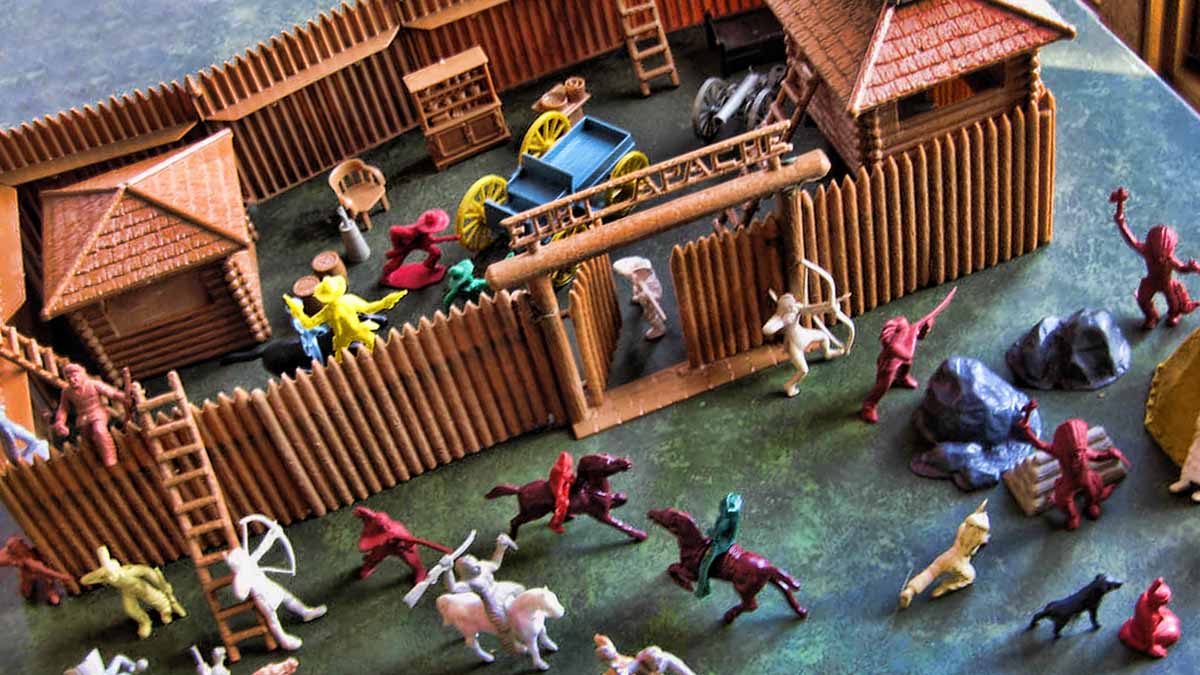
(Louis, not Karl)
Elsewhere on this website, I have observed that during the 1950s and 1960s, “history was in the air.” Marx playsets were both a reason and consequence of that phenomenon. Early in the fall, the catalogue from the Sears, Roebuck & Co. arrived in towns and cities across the nation. Then, eager boys gathered round to see what Louis Marx and Company had on offer for Christmas. Sears, of course, gave us plenty of time to place our orders with Santa.
On December 26, the neighborhood boys assembled to show off our “army men.” We then retired to backyard battlefields and combined our forces. At times, Santa Anna’s soldados would fight Hitler’s Nazis or King Arthur’s knights. Even then, we understood that such an amalgamation was anachronistic—although, I promise you, we didn’t know that particular word.
It didn’t matter.
We just thought it was nifty to see dozens of plastic figures arrayed in battle formation. But the best thing: playing in the dirt with your buddies.
During early-1940s—before any of us “Boomers” had arrived on the scene—the war effort had gobbled up most available metal resources. Even after VJ Day, metal was in high demand. but in short supply. Traditionally, manufacturers cast toy soldiers in a lead alloy, but in the post-war years they became cost prohibitive. Louis Marx anticipated this difficulty and provided the solution. In 1947, he created the plastics department at his Glen Dale factory. His timing was impeccable; the first of the “Baby Boomers” came along in 1946. As our numbers increased, we provided Louis Marx and Company with a powerful customer base.
God knows, I did my part. Marx frequently imprinted his products with the slogan, “One of the many Marx toys, have you all of them?” Well, no, I didn’t—but I had quite a few.
During the 1950s and 60s, the use of plastic allowed Marx to develop an extensive series of what he called “playsets.” These arrived in heavy cardboard boxes held together with enormous brads. Dad had to employ his pocket knife to help me pry open this chest of treasures. Once inside, these boxes contained paper bags filled with plastic figures in a variety of colors, along with numerous accessories. I still remember the excitement of discovering what each new bag included. Playsets incorporated highly realistic plastic figures and boasted some of the toy world’s finest tin lithography. Although every Marx playset box was chockablock with kid-friendly contents, they rarely cost more than four to seven dollars. In the early-1960s, even the expanded sets (such as “Giant Ben Hur”) sold between ten and twelve dollars. In 1960, of course, ten bucks bought a lot more than it does now. But even then, Marx playsets were well within the lower middle class budget of the Hardin household.
Playsets included animals, scenery, wagons, and battlefield features unique to the period. The “exploding bunker” that graced the “Battleground” playset allowed us to place paper caps, small discs of shock-sensitive explosive compounds, which simulated the noise and smoke of a shell hit. Most sets included a center piece such as the tin church (with a detachable parapet) and walls for the “Alamo” set, or a plantation house for the “Blue & Gray” set, or plastic stockade walls and blockhouses in the “Fort Apache” set. Through the use of a wire projection system, cannon in the “Alamo” set fired diminutive plastic shells. I still recall the distinct ping these made as they careened off the tin walls.
Fashions change, even in the toy world. Perhaps, especially in the toy world. In 1972, Marx sold his company to the Quaker Oats Company for $54 million and retired at seventy-six years of age.
By 1979, most US operations had ceased. By 1980, the last Marx plant closed. In the early 1980s, all Marx assets were liquidated. Mr. Marx passed away on February 5, 1982, at the age of eighty-five. By then, we Boomers were adults with kids of their own. Sadly, our kids played computer games; plastic soldiers seemed hopelessly old hat.
Louis Marx made history fun. But his playsets were also educational, displaying remarkable attention to detail. Inspired by our playsets, many of us actually read books concerning the various subjects. Nowadays, I enjoy playing computer games with my grown son; many of them are extremely well done. Still, I feel sorry for today’s boys. They will never know the joy of breaking open those gigantic cardboard boxes on Christmas morning; or having all the neighborhood urchins consolidate their “army men” the day after Christmas; or the tactile sensation of physically moving individual figures across the floor. Nor will they ever hear the magical sound of miniscule plastic shells striking superbly lithographed tin walls.
I wouldn’t trade those memories for anything.

January, 1957. Here I am playing with the Marx “Fort Apache” playset that Mom and Dad bought for my birthday. In the upper left, one can see the plastic stockade walls and blockhouse. The cannon and teepee on the floor were typical of the accessories that playsets featured. The toy service station placed neatly on the table behind my head may well have been a Marx product; I don’t recall. Even then, I found military themed toys far more alluring. Note the cowboy boots. Texan to my toenails!
